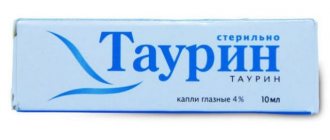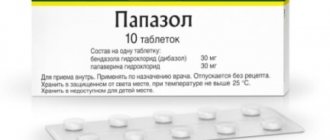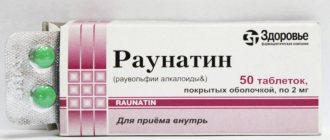Composition, release form
is Germany (Rottendorf Pharma GmbH, ABBOTT PRODUCTS GmbH). The drug in question has the ATC code C02AC05. Its Latin name is Physiotens. This medication is sold in pharmacies under the trade name “Physiotens”. The international nonproprietary name is Moxonidine. The drug is produced in the form of film-coated tablets.
Tablets are produced in various dosages. Let us indicate the composition of the drug with a dose of 0.2 milligrams:
- The active substance is moxonidine (0.2 mg).
- Excipients used include magnesium stearate (0.03 mg), povidone (0.70 mg), lactose monohydrate (95.8 mg), crospovidone (3 mg).
- The tablet shell includes ethylcellulose (1.20 mg), hypromellose (1.3 mg), red iron oxide dye (0.0025 mg), talc (0.9975 mg), titanium dioxide (1.25 mg).
With a tablet dosage of 0.3 milligrams, its composition has some differences:
- Active substance (moxonidine) – 0.3 mg.
- Excipients are: povidone (0.70 mg), magnesium stearate (0.30 mg), lactose monohydrate (95.7 mg), bloodpovidone (3 mg).
- The shell is represented by the following substances: ethylcellulose (1.2 mg), iron dye “red oxide” (0.025 mg), hypromellose (1.3 mg), talc (0.975 mg), titanium dioxide (1.25 mg), macrogol (0 .25 mg).
With a tablet dosage of 0.4 milligrams, their composition is as follows:
- The active substance is used in a volume of 0.4 mg.
- Auxiliary components are: magnesium stearate (0.3 mg), lactose monohydrate (95.6 mg), crospovidone (3 mg), povidone (0.7 mg).
- The shell consists of the following components: red iron oxide dye (0.125 mg), macrogol (0.25 mg), hypromellose (1.3 mg), titanium dioxide (1.25 mg), ethylcellulose (1.2 mg), talc ( 0.875 mg).
The tablets are round in shape, biconvex, coated. The color of the tablets differs depending on the dosage:
- 0.2 milligrams – pale pink, engraved “0.2”;
- 0.3 milligrams – pink, engraved “0.3”;
- 0.4 milligrams – brown-pink, engraved “0.4”.
One box contains 1, 2, 7 blisters, each containing 14 tablets.
Information about the drug
Physiotens is based on a substance with an international nonproprietary name (INN) – moxonidine. Auxiliary components in its composition:
- N-vinyl-2-pyrrolidinone;
- MCC;
- Titanium and iron oxide;
- Milk sugar;
- Ethylcellulose;
- Magnesium salt of stearic acid;
- Polyvinylpyrrolidone.
The release form of the drug is pink coated tablets. The package contains 14 or 28 pcs. The dosage of the active substance is 0.2, 0.3 and 0.4 mg.
Description of the active component
Moxonidine belongs to the group of I1-imidazoline receptor agonists. It has a pronounced antihypertensive effect. With a single dose of the drug with this substance, the pressure decreases by about 10%, and with strong physical activity - no more than 7%. The duration of action of moxonidine lasts for 10-12 hours, provided that the person takes the tablet on an empty stomach.
With regular use of Physiotens, a stable decrease in blood pressure is observed after 10-15 days. Systolic decreases by 25-30 mmHg. Art., and diastolic - by 15-20 mm Hg. Art. These indicators are approximate, because the effectiveness of moxonidine depends not only on the duration of taking the medicine with its content, but also on the individual characteristics of the human body.
In addition to lowering blood pressure, the substance:
- Fights myocardial hypertrophy;
- Removes manifestations of myocardial fibrosis;
- Restores blood supply to the myocardium;
- Reduces the volume of peripheral circulating blood;
- Reduces the amount of adrenaline and norepinephrine;
- Suppresses the concentration of renin and angiotensin type 2 in the blood;
- Reduces tissue resistance to insulin;
- Increases the synthesis of growth hormones.
Important!
The main indication for use of Physiotens is arterial hypertension of I-III degrees. The drug can also be taken to relieve hypertensive crises and prevent them. The advisability of using the drug in maintenance therapy after a heart attack or in the treatment of other diseases of the cardiovascular system has not been established.
Contraindications
Physiotens and other drugs with moxonidine should not be taken if you have the following diseases:
- AV conduction block type II-II;
- Heart failure in the stage of decompensation;
- Sick sinus syndrome;
- Tachycardia;
- Bradycardia;
- Severe liver/kidney dysfunction;
- Obliterating atherosclerosis of leg vessels;
- Depression;
- Epileptic seizures;
- Raynaud's disease, Parkinson's;
- Glaucoma.
Pharmacological action, pharmacodynamics, pharmacokinetics
The drug is a centrally acting antihypertensive drug. Moxonidine is able to selectively stimulate imidazoline-sensitive receptors located in the brain stem structures and which are participants in the tonic, reflex regulation of the nervous system (sympathetic). Thanks to the stimulation of these receptors, peripheral sympathetic activity and blood pressure decrease. The effectiveness of the drug has been proven by research.
Under the influence of moxonidine, the insulin sensitivity index increases by 21% (when compared with placebo). This feature is noted by doctors in obese patients with moderate arterial hypertension.
Absorption of moxonidine occurs quite quickly after taking the tablets within the upper gastrointestinal tract. The complete bioavailability of the drug reaches about 88%. The maximum concentration of the drug is reached after an hour. Eating does not affect the pharmacokinetics of the medication in question.
The connection with blood plasma proteins is 7.2%. The main metabolite is dehydrogenated moxonidine. Its pharmacological activity reaches 10% (compared to moxonidine).
The half-life of the active substance and its metabolite is 2.5 and 5 hours. respectively. More than 90% of moxonidine is excreted via the kidneys per day (of which about 78% in its original form, 13% in the form of dehydriromoxonidine). The amount of other metabolites in urine is not higher than 8% of the dose taken. Less than 1% of the drug is excreted through the intestines.
Composition and action of Physiotens
The tablets contain moxonidine in different dosages - 0.2 mg, 0.3 mg and 0.4 mg of the active substance. Excipients are:
- Povidone;
- Hypromellose;
- Lactose monohydrate;
- Ethylcellulose;
- Magnesium stearate;
- Titanium dioxide;
- Talc;
- Macrogol 6000;
- Crospovidone.
Physiotenza tablets vary in color depending on the amount of moxonidine they contain. Tablets with a dosage of 0.2 mg are pale pink, tablets with a dosage of 0.3 mg are light red, and Physiotens tablets with a dosage of 0.4 mg are matte red. All tablets are labeled indicating the amount of moxonidine they contain.
Reviews emphasize the convenience of this particular form of release, which avoids confusion with determining the required dosage and accidental abuse of the drug.
Physiotens is available in packs of 14, 28 and 96 tablets. The tablets are packaged in blisters of 14 pieces. The blisters are placed in a cardboard box, instructions for use are included.
Moxonidine, which is the main active substance of the drug Physiotens, has a hypotensive effect in case of high blood pressure. It selectively acts on imidazoline-sensitive receptors located in the medulla oblongata and responsible for the tonic and reflex regulation of the sympathetic nervous system.
Stimulation of imidazoline receptors reduces peripheral vascular resistance and high blood pressure. Reviews comparing other analogs that also reduce blood pressure in hypertension and contain moxonidine recommend this particular medicine.
Physiotens tablets have less affinity for alpha-adrenergic receptors, and therefore this drug effectively reduces blood pressure, but does not have a sedative effect and does not cause drying of the mucous membrane in the mouth.
In addition, as studies prove and reviews confirm, Physiotens is able to increase insulin sensitivity by 21% in patients suffering from moderate arterial hypertension, accompanied by obesity and insulin resistance.
Contraindications
The medication in question is not prescribed to all hypertensive patients. The medicine "Physiotens" has a number of contraindications. These include:
- hypersensitivity to the active substance, auxiliary components;
- severe bradycardia;
- sick sinus syndrome;
- age under 18 years (due to the lack of data on the safety of the drug in the treatment of children);
- galactose intolerance, glucose-galactose malabsorption, lactase deficiency.
The tablets should be taken with caution in patients:
- with severe, end-stage renal failure;
- having severe liver failure;
- on hemodialysis.
At what pressure?
Do the instructions for use that accompany the drug Physiotens indicate at what pressure to use it? We are not talking about one-time cases of increased pressure. This medicine is recommended for patients with varying degrees of hypertension.
The tonometer readings may look like this:
- 140-159/90-99 mm Hg. Art. (1st degree).
- 160-179/100-109 mm Hg. Art. (2nd degree).
- 180 and above/110 and above mm Hg. Art. (3rd degree).
The drug is usually well tolerated by patients. Its effectiveness is not related to food intake.
You should not take Physiotenza tablets if you accidentally increase your blood pressure during a hypertensive crisis.
Instructions for use
Anti-pressure tablets "Physiotens" are taken orally. The use of the medicine does not depend on food intake. Typically, the initial dose of the drug is 0.2 milligrams per day. The maximum dosage prescribed by a specialist at one time is considered to be 0.4 milligrams. The maximum daily dose is 0.6 mg, which should be divided into 2 doses.
The daily dose for patients with renal failure (moderate, severe), as well as those on hemodialysis, is 0.2 mg per day. If necessary, the specialist can increase the dosage to 0.4 mg.
Indications for use
Physiotens are tablets that are used to treat arterial hypertension. The medication is taken in the only case - if it was prescribed by a doctor after a careful examination of the patient.
Physiotens tablets 0.4 mg
Externally, it looks like this - the film coating covering the round, biconvex tablets is pinkish-brown in color, engraved “0.4” on one side. The inside of the product is painted white.
Physiotens, whose composition is complex, contains several components in addition to moxonidine: lactose monohydrate, crospovidone, magnesium stearate, povidone. The drug shell is also composed of several substances: hypromellose, ethylcellulose, macrogol, talc, red iron oxide dye, titanium dioxide.
Tablets are indicated for patients whose hypertension is caused by obesity, or their condition is aggravated by type 2 diabetes.
Most often, Physiotens is prescribed simultaneously with other drugs that reduce blood pressure, so that the effect is combined.
This method allows you to achieve excellent results, the patient’s blood pressure returns to normal, his blood pressure readings reach 140/90 mm Hg. and below.
Physiotens is a medicine that quickly allows you to achieve a significant reduction in blood pressure. However, only a specialist can prescribe it.
Side effects
Now let’s look at what side effects the high blood pressure drug “Physiotens” has.
- Central nervous system symptoms include drowsiness, headache, sleep disturbance, and dizziness.
- In the cardiovascular system, orthostatic hypotension and an excessive decrease in blood pressure occur.
- On the part of the skin and subcutaneous fat, doctors note itching, skin rash, and angioedema.
- Nausea and dry mouth may occur in the gastrointestinal tract.
- Among the common side effects, doctors note asthenia.
The symptoms listed above gradually decrease (during the first weeks of drug therapy).
Physiotens
Physiotens is a special selective antagonist of imidazoline receptors, which are responsible for reflex as well as tonic control of the functioning of the sympathetic nervous system, localized in the medulla oblongata.
This drug helps to quickly and effectively lower blood pressure. It should be noted that long-term use of this drug significantly weakens left ventricular myocardial hypertrophy and reduces peripheral vascular resistance, relieves the patient from signs of myocardial fibrosis and manifestations of microarteriopathy.
The effect of the tablets in most cases lasts about twelve hours, because its active substance is removed quite slowly from the central nervous system.
Clinical and pharmacological group
Antihypertensive agent.
Terms of sale from pharmacies
Can be purchased with a doctor's prescription.
Price
How much does Physiotens cost in pharmacies? The average price is 300 rubles.
Composition and release form
Physiotens is available in the form of film-coated pink tablets.
The main active ingredient of Physiotens is moxonidine.
- Depending on the amount of moxonidine included in one tablet, Physiotens 200, 300 and 400 mcg are produced.
The excipients of Physiotens are: povidone, lactose monohydrate, magnesium stearate, crospovidone.
The shell contains ethylcellulose, hypromellose, talc, macrogol, titanium dioxide, dye.
Pharmacological effect
The drug is part of the group of central antagonists of imidazoline receptors, which are responsible for the tonic, reflex regulation of the sympathetic nervous system, including hypertension due to the malfunction of these receptors. When entering the human body, the components bind to adrenergic receptors and reduce the activity of the secretion of the hormone adrenaline.
As a result, the drug has the following positive effects:
- Normalizes the sympathetic activity of the nervous system.
- During long-term use, it strengthens myocardial vessels, kidneys, and intestinal walls.
- Helps lower blood sugar and improve overall health - relieves dizziness, angina, acts as a mild diuretic.
- Corrects arterial hypertension, having a pronounced hypotensive effect. Physiotens is considered the first choice drug for hypertensive crisis.
Does not have a sedative effect, does not cause drowsiness, or impaired concentration. Absorption is up to 90%. Metabolites are excreted in the urine, 80% unchanged. The full withdrawal cycle is 24 hours. About one percent of metabolites are excreted in the feces.
Residual substances do not accumulate in the body and do not produce long-term effects on organ systems. In elderly patients, minor variations may occur due to metabolic changes, but the variations are not considered clinically significant.
Prescription during pregnancy and lactation
Women while pregnant should take pills only as a last resort, if the benefit to the mother significantly outweighs the possible existing risk to the health and normal development of the fetus.
It is recommended to replace Physiotens with a more gentle analogue.
During lactation, it is better to avoid breastfeeding, because the active ingredient of the drug can be excreted along with milk, entering the child’s body.
Dosage and method of administration
As indicated in the instructions for use, Physiotens is taken orally, regardless of the time of meal. Typically, Physiotens and its analogues are prescribed in a volume of 200 mcg per day, the maximum permissible dose per day is 600 mcg of the active substance, the maximum possible single dose is 400 mcg.
In case of a possible overdose of Physiotens, which causes headache, drowsiness, and decreased blood pressure, it is recommended to restore circulating blood volume by introducing fluid and dopamine.
If renal failure is detected in a patient, the daily dose of Physiotens should be 200 mcg; if well tolerated, the dose can reach 400 mcg.
Adverse reactions
When using the drug Physiotens, various side effects may occur. The mechanism of their manifestation is closely related to the particular characteristics of the body of a particular patient. Among the list of side effects are:
- noise in ears;
- a sharp decrease in blood pressure;
- development of hypotension;
- manifestation of pain in the temple area;
- dizziness;
- increased drowsiness;
- feeling of dryness in the mouth;
- insomnia;
- decrease in heart rate;
- disorders of the gastrointestinal tract;
- allergic rashes on the skin.
Side effects that appear in the first 2-3 days of use are a natural reaction of the body.
If such a manifestation does not lead to a significant deterioration in the patient’s well-being, dose adjustment and discontinuation of the drug are not required.
If the described symptoms are intense, the drug Physiotens should be replaced with an analogue with another active ingredient. The prescription of a drug with another active ingredient should be carried out by a specialist.
Compatibility with other drugs
When using the drug, it is necessary to take into account interactions with other medications:
- The combined use of moxonidine with other antihypertensive drugs leads to an additive effect.
- Moxonidine may moderately improve impaired cognitive function in patients receiving lorazepam.
- Moxonidine may enhance the sedative effect of benzodiazepine derivatives when administered simultaneously.
- Moxonidine may enhance the effect of tricyclic antidepressants, tranquilizers, ethanol, sedatives and hypnotics.
- Tricyclic antidepressants may reduce the effectiveness of centrally acting antihypertensive drugs, so their use together with moxonidine is not recommended.
- Moxonidine is released by tubular secretion. Therefore, its interaction with other drugs released by tubular secretion is not excluded.
Overdose
In clinical practice, there are cases of overdose of the drug in question without death. In this case, the patient took a large dose of Physiotens (19.6 mg) at one time. Signs of an overdose are:
- drowsiness;
- fatigue;
- headache;
- bradycardia;
- sedative effect;
- pronounced decrease in blood pressure;
- asthenia;
- pain in the epigastric region;
- vomit;
- dry mouth;
- dizziness.
The following reactions are potentially possible:
- tachycardia;
- short-term increase in pressure;
- hyperglycemia.
There is no specific antidote for overdose:
- If blood pressure has dropped significantly, it is enough to restore the volume of circulating blood by introducing fluid, dopamine.
- Atropine can be used to relieve bradycardia.
- To reduce and eliminate paradoxical hypertensive effects, alpha-adrenergic receptor antagonists are taken.
Dosage and method of administration
As indicated in the instructions for use, Physiotens is taken orally, regardless of the time of meal. Typically, Physiotens and its analogues are prescribed in a volume of 200 mcg per day, the maximum permissible dose per day is 600 mcg of the active substance, the maximum possible single dose is 400 mcg.
In case of a possible overdose of Physiotens, which causes headache, drowsiness, and decreased blood pressure, it is recommended to restore circulating blood volume by introducing fluid and dopamine.
If renal failure is detected in a patient, the daily dose of Physiotens should be 200 mcg; if well tolerated, the dose can reach 400 mcg.
Interaction with other drugs
- Doctors prescribe Physiotensa with slow calcium channel blockers, thiazide diuretics, and other antihypertensive drugs. Using these drugs and Physiotens at the same time can provoke an additive effect.
- If you take moxonidine with glibenclamide, hydrochlorothiazide, digoxin, pharmacokinetic interaction will not occur.
- It is not recommended to use tricyclic antidepressants with Physiotens, because they reduce the effectiveness of centrally acting antihypertensive drugs.
- Taking Physiotens and benzodiazepines at the same time increases the sedative effect of the latter.
- When patients take lorazepam and moxonidine simultaneously, there is an improvement in weakened cognitive functions.
- The simultaneous use of Physiotens with moclobemide does not result in pharmacodynamic interaction.
Cost and analogues
Three pharmacological enterprises are engaged in the production of medicines under the name “Physiotens”:
- Abbott Laboratories (USA),
- Meylan Laboratories (France),
- Solvay SA (Belgium).
A package of tablets from these manufacturers costs between 400-500 rubles for 14 pieces. with a minimum dosage of moxonidine. They are sold without a prescription.
If the original medicine is not suitable for a person because of its price, then he is recommended to choose Physiotenza analogues with a different trade name, which cost almost half the price:
- Tsint,
- Tenzotran,
- Moxonidine SZ (Russian drug),
- Moksonidin KAHOH,
- Moxarel,
- Moxonitex Sandoz
- Moxogamma.
Important! Although Physiotens and its substitutes are sold without a prescription, they should be used only after undergoing laboratory diagnostics and establishing a diagnosis.
The cheapest of the listed drugs is domestic Moxonidine from the pharmaceutical company Severnaya Zvezda (Leningrad region). Its cost does not exceed 150 rubles for 15 tablets of 0.2 mg of active ingredient.
If it is impossible to use Physiotens for medical reasons, doctors prescribe to the patient its foreign and Russian analogues with a different composition, but a similar principle of action:
- Vidal,
- Albarel,
- Estulik,
- Tenaxum,
- Kapoten.
They quickly reduce blood pressure and help cope with a hypertensive crisis, but have other side effects, contraindications and methods of administration. In order not to harm your health, you should consult a doctor before choosing Physiotens analogues.
Use by pregnant and breastfeeding women
There are no clinical data regarding treatment with the tablets in question. Animal studies have been conducted. According to the results of the experiment, no negative impact on the course of pregnancy, the development of the embryo, fetus, childbirth, or postnatal development of the offspring was established.
Doctors prescribe Physiotens to pregnant women with caution, after a preliminary risk/benefit assessment. If the benefit to the mother outweighs the risk to the fetus, the doctor prescribes the tablets in a certain dosage.
Moxonidine can pass into breast milk. If the tablets are prescribed during lactation, the woman should stop breastfeeding.
special instructions
If it is necessary to cancel beta-blockers and Physiotens taken by the patient at the same time, beta-blockers are canceled first. Physiotens is stopped after several days.
During treatment with Physiotens, regular measurement of blood pressure, ECG, and heart rate is required. People usually stop taking pills gradually.
The drug in question causes drowsiness and dizziness, so you should be careful when getting behind the wheel of a car or about to operate other mechanisms. Before using this antihypertensive drug, you must study in detail its description, composition, interaction with other medications, and also read the instructions for it.
Analogs
Physiotens tablets can be replaced, if necessary, with one of the drug’s analogues. A specialist must prescribe a substitute. The most common analogue of the medication in question is Moxogamma. This medicine contains the same active substance as in Physiotensa.
Important: In the treatment of arterial hypertension, it is necessary to use the medicine prescribed by the attending physician. Self-medication can negatively affect your health.
Also, a cardiologist can prescribe other analogues of the medication:
- "Clonidine";
- "Tenaxum";
- "Moxonitex";
- "Tensotran";
- "Estupik."
Video on the topic
How to take Physiotens if you have high blood pressure? The method of using the medicine and its benefits are covered in detail in this video:
In order for the quality of your life to be at the highest level at certain moments, it is necessary to connect new generation drugs to support health, such as the antihypertensive Physiotens, which can help solve both the problem associated with blood pressure and the problem of excess weight.
The information on the MyMedNews.ru website is for reference and general information, collected from publicly available sources and cannot serve as a basis for making a decision on the use of medications in the course of treatment.
MyMedNews.ru
And we also have
About the combined use of the drug Nebilet and alcohol, the possible consequences of such a “mix”
Reviews
The majority of patients with hypertension who were treated with the medication in question left positive reviews about it. They noted that long-term use of tablets helps to very effectively lower blood pressure, including during hypertensive crises.
The most common side effects are dry mouth, dizziness and headache. Typically, these adverse reactions go away on their own after a couple of weeks of taking Physiotens.
In correspondence on forums, patients focus on the nuance that the medicine cannot be discontinued abruptly. It is also undesirable to skip the next dose of pills. The downside is that the medicine is not cheap.
The doctor's review of Physiotensa can be seen in the video.
Contraindications and side effects
Physiotens, like all antihypertensive drugs, has many side effects. This does not mean that the medicine is poorly tolerated and you should look for an analogue. Most of the side effects disappear after the body adapts to the active component of the drug. At the initial stage of treatment with this drug, the following symptoms are possible:
- Drowsiness;
- Pronounced and sharp decrease in blood pressure;
- Dizziness and headaches;
- Asthenia;
- Fainting conditions;
- Drying of the oral mucosa;
- Orthostatic hypotension;
- Bradycardia;
- Skin rash like urticaria;
- Nausea and vomiting;
- Intestinal disorders – diarrhea;
- Itching and angioedema;
- Increased excitability;
- Tinnitus;
- Pain in the neck, back, lower back;
- Swelling of the upper and lower extremities.
There are also certain contraindications to the use of this medication - before starting therapy, you should carefully study them, consult a doctor, and, if in doubt, select analogues. An analogue may be required in the following cases:
- For sick sinus syndrome.
- Severe bradycardia - heart rate does not exceed 50 per minute.
- AV block of 2 or 3 degrees of severity.
- Heart failure in acute or chronic form.
- Galactose intolerance, lactase deficiency or malabsorption of glucose and galactose, caused by genetics.
- Some physiological conditions of the patient, age factor.
- Individual intolerance to the main or auxiliary components of the drug.
It should be noted that analogues have similar side effects and contraindications, therefore, before abandoning Physiotens and looking for analogues, it makes sense to adjust the dosage and reduce the factor that provokes the development of possible side effects.
To avoid unwanted reactions and poisoning, it is not recommended to take the drug simultaneously with alcohol or other medications that have a sedative effect.
Do not combine Physiotens with tricyclic antidepressants, tranquilizers, or drugs containing benzodiazepine.
You cannot take these tablets and their analogues with a hypertensive effect and the same active substance at the same time - this will lead to overdose and intoxication.
Approximate price in Russia
The cost of the medication in question depends on a number of factors (dosage of tablets, city, pharmacy rating, etc.). Thus, the price of Physiotens tablets (14 pieces) with a dosage of 0.2 milligrams is approximately 226 rubles. The same number of tablets with a dosage of 0.4 milligrams will cost approximately 420 rubles.
Did you like the article? Save it!
Still have questions? Ask them in the comments! Cardiologist Mariam Harutyunyan will answer them.
Ivan Grekhov
Graduated from the Ural State Medical University with a degree in General Medicine. General practitioner








